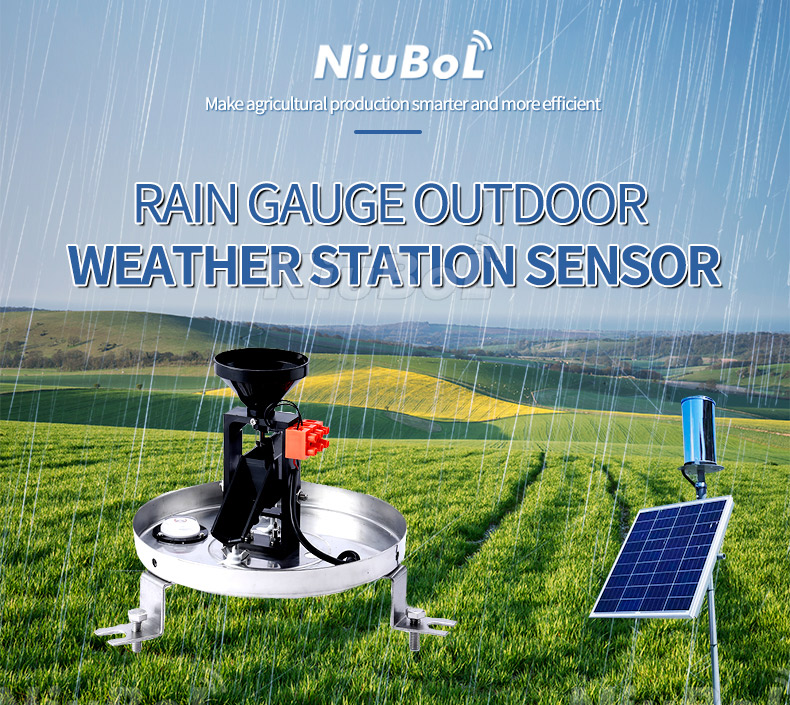

— Blogs —
—Products—
 Consumer hotline +8618073152920
Consumer hotline +8618073152920 WhatsApp:+8615367865107
Address:Room 102, District D, Houhu Industrial Park, Yuelu District, Changsha City, Hunan Province, China
Product knowledge
Time:2024-07-28 16:41:18 Popularity:371
Discover the precise world of rainfall sensors: from ABS to stainless steel, from single to double tipping buckets for precision measurements

In many fields such as meteorological observation, hydrological monitoring and agricultural irrigation management, accurate recording of rainfall is a crucial part of the process. With the progress of science and technology, rainfall sensor technology is also changing day by day, among which, ABS tipping bucket rain gauge, stainless steel tipping bucket rain gauge and double tipping bucket rain gauge have become the mainstream products in the market with their unique advantages. And for different accuracy requirements, such as 0.5mm and 0.2mm and 0.1mm subdivision, but also for the fine monitoring provides the possibility. Today, we will analyse these rain sensors in depth and explore the way of accurate measurement behind them.
The ABS (Acrylonitrile Butadiene Styrene) tipping bucket rain gauge is the preferred choice for many basic weather and agricultural monitoring stations due to its lightweight material and economical cost. The principle of operation is based on the tipping of a bucket to record rainfall. When a certain amount of rainwater accumulates in the bucket, the bucket is tipped over by gravity and this action is converted into an electrical signal by a sensor for recording. the ABS material not only ensures that the device is lightweight, but is also corrosion-resistant, making it suitable for use in normal climatic conditions. The datasheet gives a clear view of key parameters such as the measuring range, accuracy (e.g. ±0.2mm or higher depending on the model), response time and the temperature and humidity range of the operating environment, providing users with a comprehensive overview of performance.
The superior corrosion resistance and longer service life of the stainless steel tipping bucket rain gauge compared to ABS make it the ideal choice for users seeking long-term stability and high accuracy. The stainless steel material is able to effectively resist the erosion of harsh weather and complex environments, ensuring the long-term stable operation of the equipment. Its tipping bucket structure and measuring principle are similar to that of the ABS tipping bucket type, but the difference in material allows the stainless steel rain gauge to maintain high accuracy measurements even under extreme conditions. In data sheets, stainless steel rain gauges are often labelled with higher accuracy levels and wider measurement ranges, as well as lower maintenance costs, reflecting their unique value as high-end products.
The double-bucket rain gauge is an innovative upgrade of the traditional single-bucket structure. By introducing the double bucket design, it achieves double calibration and faster response to rainfall. When one bucket collects a pre-set amount of rainwater and turns over, the other bucket enters into operation immediately. This alternate operation not only improves the measurement efficiency, but also further enhances the accuracy and reliability of the measurement. The high frequency response and finer resolution (e.g. 0.1mm) of the dual-bucket rain gauge are usually emphasised for monitoring scenarios that are extremely sensitive to rainfall variations.
0.5mm and 0.2mm accuracy: fine measurements for different requirements
Whether it is ABS, stainless steel or double-bucket rain gauges, they can be supplied with different accuracy versions according to users' needs, with 0.5mm and 0.2mm being the common accuracy standards. 0.5mm accuracy is suitable for general meteorological observation and hydrological monitoring, while 0.2mm accuracy is more suitable for scientific research experiments and agricultural precision irrigation, which are extremely sensitive to the changes in rainfall. By choosing different precision rain gauge, users can more accurately grasp the rainfall situation, providing strong support for decision-making.
In summary, the continuous progress of rain sensor technology provides us with more diversified and high-precision measurement tools. The design innovation from ABS flip bucket type to stainless steel flip bucket type, to double flip bucket type, as well as the refined measurement of 0.5mm and 0.2mm, all reflect the wide application and in-depth development of science and technology in the field of meteorological monitoring. Through in-depth analysis of these data sheets, we can not only better understand the performance characteristics of these rainfall sensors, but also provide a scientific reference basis for practical applications.
NBL-W-ARS-Tipping-bucket-rain-gauge-instruction-manual.pdf
NBL-W-RS-Rain-sensors-instruction-manual-0.2mm.pdf
NBL-W-RS-Tipping-bucket-rain-gauge-instruction-manual-0.5mm.pdf
NBL-W-DRS-Double-Tipping-Bucket-Rain-Sensor-Instruction-Manual.pdf
Related recommendations
Sensors & Weather Stations Catalog
Agriculture Sensors and Weather Stations Catalog-NiuBoL.pdf
Weather Stations Catalog-NiuBoL.pdf
Related products
 Combined air temperature and relative humidity sensor
Combined air temperature and relative humidity sensor Soil Moisture Temperature sensor for irrigation
Soil Moisture Temperature sensor for irrigation Soil pH sensor RS485 soil Testing instrument soil ph meter for agriculture
Soil pH sensor RS485 soil Testing instrument soil ph meter for agriculture Wind Speed sensor Output Modbus/RS485/Analog/0-5V/4-20mA
Wind Speed sensor Output Modbus/RS485/Analog/0-5V/4-20mA Tipping bucket rain gauge for weather monitoring auto rainfall sensor RS485/Outdoor/stainless steel
Tipping bucket rain gauge for weather monitoring auto rainfall sensor RS485/Outdoor/stainless steel Pyranometer Solar Radiation Sensor 4-20mA/RS485
Pyranometer Solar Radiation Sensor 4-20mA/RS485
Screenshot, WhatsApp to identify the QR code
WhatsApp number:+8615367865107
(Click on WhatsApp to copy and add friends)